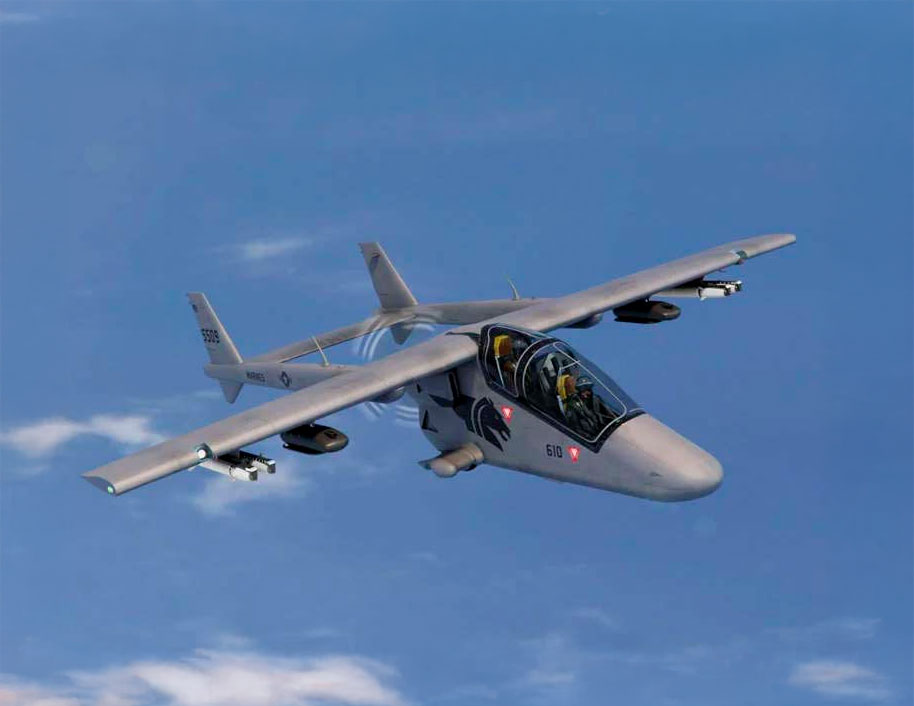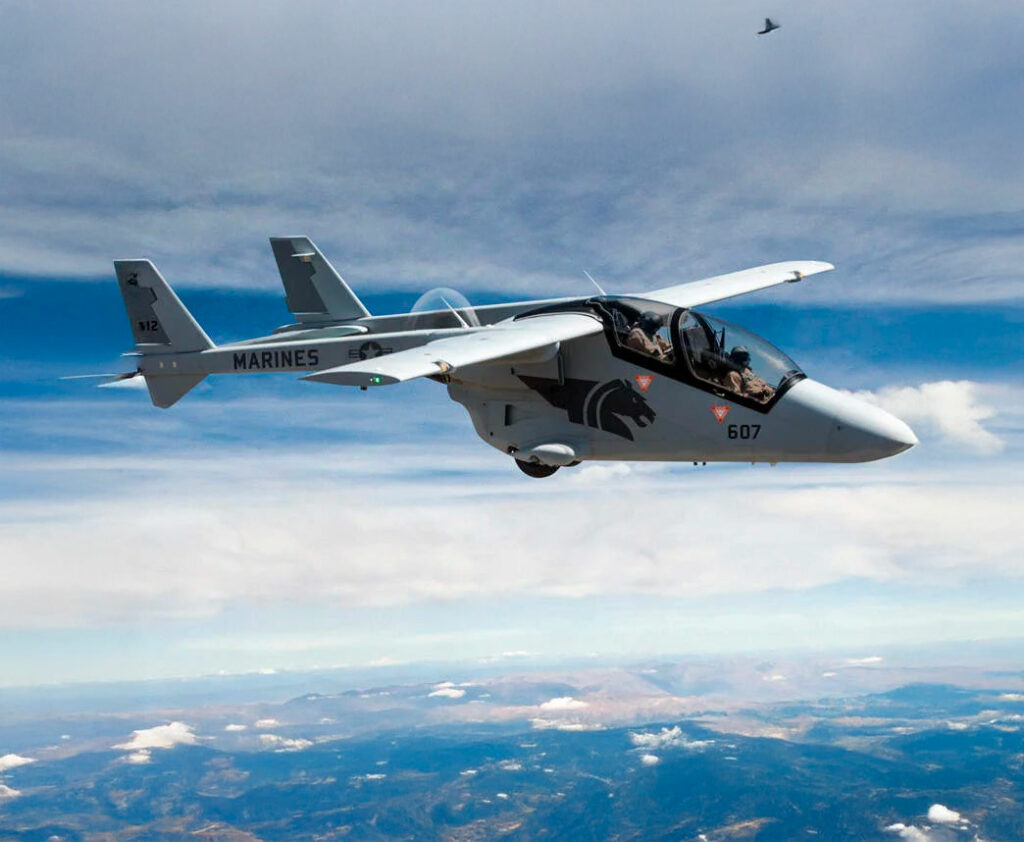The Bronco II is a light-attack and close-air support aircraft with a pusher-propeller design, tandem seating, and six underwing hardpoints for various munitions.
The Bronco Combat Systems Bronco II is a light-attack and close-air support (CAS) aircraft developed for asymmetrical warfare and intelligence, surveillance, and reconnaissance (ISR) missions. Based on the South African AHRLAC platform, it features a high-mounted forward-swept wing, twin-boom tail, and pusher-propeller configuration. The aircraft accommodates two crew members in a tandem seating arrangement and is powered by a single turboprop engine. It boasts six underwing hardpoints capable of carrying precision-guided munitions and other weaponry. The Bronco II’s modular design includes an Interchangeable Multi-Mission System Bay (IMSB), allowing rapid reconfiguration for various roles, including C4ISR and precision strike operations. Its design emphasizes mission flexibility, rapid deployment, and operation from austere environments with minimal logistical support.
History of the Development of the Bronco Combat Systems Bronco II
In the late 2000s, the increasing prevalence of asymmetrical warfare highlighted the need for a versatile, cost-effective aircraft capable of performing both light-attack and ISR missions. Traditional high-performance jets were often ill-suited for counter-insurgency operations due to their speed, operating costs, and logistical requirements. Recognizing this gap, the South African companies Paramount Group and Aerosud initiated the development of the Advanced High-Performance Reconnaissance Light Aircraft (AHRLAC) in 2009.
The AHRLAC was conceived as a purpose-built platform, distinct from modified civilian aircraft, to address the specific needs of modern warfare. Its design featured a high-mounted forward-swept wing, twin-boom tail, and a pusher-propeller configuration, optimizing it for low-speed maneuverability and extended loitering capabilities. The aircraft’s modular architecture allowed for the integration of various mission systems, catering to a wide range of operational requirements.
The prototype AHRLAC conducted its maiden flight on July 26, 2014, marking a significant milestone in its development. Following successful testing phases, the developers sought to introduce the aircraft to the international market, particularly targeting the United States, where there was a growing interest in light-attack platforms for counter-insurgency and special operations.
In February 2018, Bronco Combat Systems (BCS) USA was established as a collaboration between Paramount Group, Fulcrum Concepts, and Aerospace Development Corporation (ADC) to adapt and market the AHRLAC for the U.S. military. The aircraft was rebranded as the Bronco II, paying homage to the original North American Rockwell OV-10 Bronco, a twin-engine light-attack and observation aircraft that had seen extensive service during the Vietnam War.
The Bronco II was tailored to meet U.S. requirements, incorporating significant American content and planning for full production within the United States. This move aimed to align the aircraft with U.S. military standards and facilitate its consideration for various defense programs. Notably, the Bronco II was proposed for the U.S. Special Operations Command’s (USSOCOM) Armed Overwatch program, which sought a deployable and sustainable multi-mission aircraft supporting special operations forces in austere and permissive environments.
The development of the Bronco II reflects a strategic response to the evolving nature of warfare, emphasizing versatility, cost-effectiveness, and the ability to operate in diverse environments. Its design and capabilities position it as a contemporary solution for modern military forces seeking adaptable platforms for light-attack and ISR missions.

Design of the Bronco Combat Systems Bronco II
The Bronco II exhibits a distinctive design tailored for versatility and operational efficiency in light-attack and ISR roles. Its airframe features a high-mounted forward-swept wing, enhancing aerodynamic stability and providing improved lift characteristics at lower speeds. The twin-boom tail configuration, coupled with a single horizontal stabilizer, contributes to its structural integrity and control responsiveness.
A notable aspect of the Bronco II’s design is its pusher-propeller configuration, where the engine is mounted at the rear, driving a propeller that pushes the aircraft forward. This arrangement offers several advantages, including unobstructed forward visibility for the crew, reduced risk of foreign object damage to the engine during takeoff and landing, and enhanced safety during ground operations.
The aircraft accommodates two crew members in a tandem seating arrangement, with the pilot positioned in the front cockpit and the systems operator or observer in the rear. This configuration facilitates effective communication and coordination during complex missions. The cockpits are equipped with modern avionics and large multifunction displays, providing real-time data and situational awareness to the crew.
One of the Bronco II’s key design features is its Interchangeable Multi-Mission System Bay (IMSB), an internal modular bay located beneath the fuselage. The IMSB allows for rapid reconfiguration of the aircraft to perform various roles, such as intelligence gathering, surveillance, reconnaissance, and precision strike missions. This modularity enables operators to tailor the aircraft’s capabilities to specific mission requirements without extensive downtime.
The Bronco II’s tricycle-type retractable landing gear comprises two fuselage-mounted main gears and a nose wheel unit, facilitating operations from unprepared airstrips. This design enhances the aircraft’s short takeoff and landing (STOL) capabilities, allowing it to operate in austere environments with minimal infrastructure.
The aircraft’s open architecture and plug-and-play systems enable the integration of various sensors and mission equipment. This flexibility allows operators to tailor the Bronco II’s capabilities to specific mission requirements, enhancing its operational effectiveness across a range of scenarios.
In terms of survivability, the Bronco II can be equipped with an electronic self-protection suite, providing defense against various threats encountered during missions. Additionally, the aircraft’s design allows for the incorporation of armor plating to protect critical systems and crew members, further enhancing its resilience in hostile environments.
Performance of the Bronco Combat Systems Bronco II
The Bronco II is powered by a single Pratt & Whitney PT6A-66B turboprop engine, delivering 950 shaft horsepower (708 kW). This powerplant enables the aircraft to achieve a maximum cruise speed of approximately 230 knots (265 mph or 426 km/h) and operate at a service ceiling of 21,000 feet (6,400 meters).
The aircraft’s range and endurance are notable, with the ability to remain airborne for more than seven hours. This extended loiter time is particularly advantageous for ISR missions and close air support operations, allowing the Bronco II to provide sustained coverage over areas of interest.
The Bronco II’s short takeoff and landing (STOL) capabilities enable it to operate from unprepared airstrips and austere environments. This flexibility allows for rapid deployment and repositioning, which is essential for supporting ground forces in dynamic combat scenarios.
When compared to similar aircraft in its class, such as the Embraer EMB 314 Super Tucano and the Beechcraft AT-6 Wolverine, the Bronco II offers competitive performance metrics. While the Super Tucano has a higher maximum speed of approximately 270 knots (310 mph or 500 km/h) and a service ceiling of 35,000 feet (10,668 meters), the Bronco II’s modular design and extended endurance provide distinct operational advantages. Similarly, the AT-6 Wolverine boasts a maximum speed of around 278 knots (320 mph or 515 km/h) and a service ceiling of 31,000 feet (9,449 meters), but the Bronco II’s STOL capabilities and mission flexibility make it a compelling alternative for various mission profiles.
In summary, the Bronco II’s performance characteristics, including its propulsion system, speed, altitude capabilities, range, and endurance, position it as a versatile and effective platform for light-attack and ISR missions. Its ability to operate in austere environments and provide sustained support to ground forces enhances its value in modern combat operations.
Variants of the Bronco Combat Systems Bronco II
The Bronco II is derived from the Advanced High-Performance Reconnaissance Light Aircraft (AHRLAC) platform, developed by AHRLAC Holdings in South Africa. The AHRLAC serves as the baseline configuration, designed primarily for ISR missions with provisions for light-attack capabilities.
The militarized version of the AHRLAC is marketed as the Mwari, which incorporates advanced mission systems, including precision weapons, targeting sensors, and electronic self-protection suites. The Mwari is tailored for armed reconnaissance and light-attack roles, offering enhanced combat capabilities over the baseline AHRLAC.
In the United States, the Mwari has been rebranded as the Bronco II, with modifications to meet U.S. military standards and requirements. The Bronco II features an open system architecture, allowing for the integration of emerging technologies and mission systems. Its Interchangeable Multi-Mission System Bay (IMSB) enables rapid reconfiguration for various roles, including ISR, close air support, and precision strike missions.
While the Bronco II is the primary variant marketed in the U.S., its modular design and open architecture allow for potential future adaptations to meet specific customer requirements. This flexibility ensures that the platform can evolve to address emerging threats and mission needs.

Military Use and Combat of the Bronco Combat Systems Bronco II
The Bronco II is designed to fulfill a range of military roles, including light-attack, close air support (CAS), and intelligence, surveillance, and reconnaissance (ISR) missions. Its modular design allows for rapid reconfiguration to meet specific mission requirements, enhancing its operational versatility.
Armament
The Bronco II is equipped with six underwing hardpoints capable of carrying a variety of weapons systems. These hardpoints can accommodate precision-guided munitions, unguided rockets, machine gun pods, and air-to-surface missiles. For instance, the aircraft can be armed with Belgian-designed FN HMP .50 caliber machine gun pods and South African-made Mokopa guided anti-tank missiles, which are available with laser, millimeter-wave radar, and infrared guidance options.
The aircraft’s weapons management system is compatible with various munitions, including the AGM-114 Hellfire laser-guided missile and the AGM-176 Griffin GPS- and laser-guided missile, as well as unguided weapons and gun pods.
Operational Use
As of now, the Bronco Combat Systems Bronco II has not been deployed in active combat operations. The aircraft was developed to address the need for a versatile, cost-effective platform capable of performing light-attack and intelligence, surveillance, and reconnaissance (ISR) missions, particularly in asymmetrical warfare scenarios. Its design emphasizes modularity, allowing for rapid reconfiguration to meet various mission requirements.
The Bronco II was proposed for the U.S. Special Operations Command’s (USSOCOM) Armed Overwatch program, which sought a deployable and sustainable multi-mission aircraft to support special operations forces in austere and permissive environments. However, as of September 2021, the Bronco II was eliminated as a contender in this program.
Despite not being selected for the Armed Overwatch program, the Bronco II remains a viable option for military forces seeking a flexible and cost-effective solution for light-attack and ISR roles. Its modular design and open architecture allow for the integration of various sensors, weapons, and mission systems, enabling it to adapt to evolving operational requirements.
The Bronco II has not been sold to other countries to date. Its developers continue to market the aircraft to potential international customers, emphasizing its versatility, cost-effectiveness, and suitability for a range of military operations.
The Bronco Combat Systems Bronco II is a purpose-built light-attack and ISR aircraft designed to meet the demands of modern asymmetrical warfare. Its high-mounted forward-swept wing, twin-boom tail, and pusher-propeller configuration provide aerodynamic efficiency and operational versatility. The aircraft’s modular Interchangeable Multi-Mission System Bay (IMSB) allows for rapid reconfiguration to suit various mission profiles, enhancing its adaptability. Powered by a Pratt & Whitney PT6A-66B turboprop engine, the Bronco II offers competitive performance metrics, including a maximum cruise speed of approximately 230 knots (265 mph or 426 km/h) and an endurance exceeding seven hours. While it has not yet been deployed in active combat, the Bronco II’s design and capabilities make it a promising candidate for future light-attack and ISR roles in diverse operational environments.
Back to the Special Aircraft section